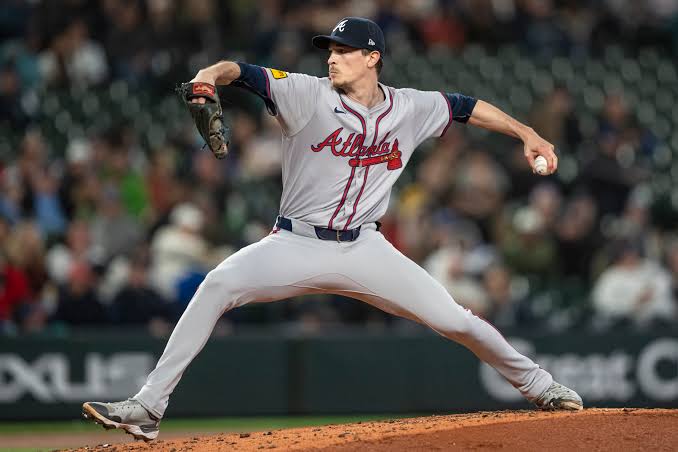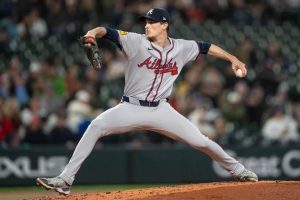

The Atlanta Braves have the best record in baseball, 19-9, thanks to solid rotation and bullpen performances, a blistering start by Marcell Ozuna, and output from the bottom of the lineup. But this cannot stay forever.
History shows that teams generate a record-breaking season when numerous players have a career year, and that is exactly what happened with the Atlanta Braves in 2023.
Ronald Acuña Jr. reached base 41.6% of the time, drove in 106 runs, and finished with a.337 average for the first time in his career. This resulted in a 170 wRC+ and 9.0 fWAR.
Austin Riley nearly replicated his 2022 season, hitting.281/.345/.516/.861 with 127 wRC+, 37 home runs, and 5.0 fWAR.
Matt Olson led the league with 54 home runs and raised his average above.267 for the first time, finishing the year with a line of.283/.389/.604/.963, 160 wRC+, and 5.5 fWAR.
After starting the season batting.073/.190/.200 with a.390 OPS and an 8 wRC+ in April, Marcell Ozuna rebounded to hit 40 home runs and bat.297/.366/.603 with a.969 OPS and 156 wRC+ from May to the end of the year, good for 3.1 fWAR from the DH position.
What goes up must come down; even superstars regress to some extent while continuing to play a level beyond everyone else. I expect everyone to finish the season with numbers near the back of their baseball cards. However, the Braves must get more from the top of their lineup soon or the season will slip away quickly.
“What goes up must come down.”
Talking about your worries is a crying sin.
Ride a painted pony, and let the spinnin’ wheel spin.
– David Clayton
Early problems at the top of the Atlanta Braves lineup cause concern.
The top of the Atlanta Braves’ lineup appears to be facing a crash rather than regression. Ronald Acuña Jr. is the most essential player in the squad right now.
Last season, Acuña swung at pitches at about the same rate while dropping his K-rate from an average of 25.3% to 11.4%, decreased popups from 8.2% to 4.7%, saw his hard-hit rate grow from 42% to 46%, and his HR/FB rate from 21.9% to 24%.
Currently, Acuña has the greatest GB rate (54.2%) and popup rate (18.8%) in his career. Simply simply, his timing is wrong; he’s either ahead or behind the pitch, which means he’s not barreling the ball as much, as evidenced by a 45% decline in barrel rate. He’s striking out at nearly his career average and walking a little more, possibly because he’s trying to be more judicious.
I’ve read suggestions that he’s exhausted from playing winter ball. I doubt he’s fatigued this early in the season, but it’s possible that facing AA-AAA pitching produced an unconscious shift in his approach.
Matt and his bat.
Matt Olson’s peripherals are not significantly different from last year. He is facing slightly more fastballs, cutters, and off-speed pitches, but not enough to call a trend yet. He’s swinging at somewhat more pitches outside the zone but fewer (-4%) inside the zone; combined, they equal up to the same swing rate as previous year.
At first glance, his BABIP appears to be low, which it is, but it is also consistent with his career average. His K-rate has increased slightly, but it still matches his.267/.351/.545.896 line from 2019. Mat is walking more than his career average, but not as much as last year, which I believe was due to pitchers’ unwillingness to deal with him.
If you only looked at the bars on Statcast, you wouldn’t know Matt was slumping.
Olson is a couple of line drives away from becoming his old self; I hope they arrive soon.
Is Austin Riley slumping?
Yes, he is, but Statcast gives strong reason to believe it could end at any time.
He’s not connecting with fastballs, but at the same rate as last year; it’s off-speed pitches like changeups, curveballs, and sliders that are bothering him, so pitchers are utilizing them more frequently.
When he first came up, his slider swings reminded me of Jeff Francoeur. Kevin Seitzer assisted him in working through it, and I believe they are reviewing the tape to see what has changed. His late-inning line drive and opposite-field batting appeared to indicate that he was – or is – on the verge of returning.
If it sounds like I’m more concerned with Acuña than Olson and Riley, you’re correct. Timing is difficult to fix. If your internal clock is a few ticks out of sync, there’s no easy way to catch up. Mark DeRosa is a major fan of using the curveball machine to repair it, while others concentrate on their timing systems.
When Ronnie is on fire, the Atlanta Braves lineup is nearly unstoppable; whenever he gets on base, he either steals a base or scores a run. When Acuña isn’t hitting, others try to fill the void. However, the World Series is most likely to be won by Acuña alone.

Leave a Reply